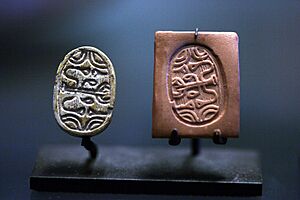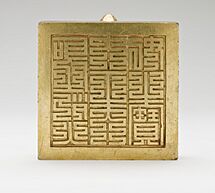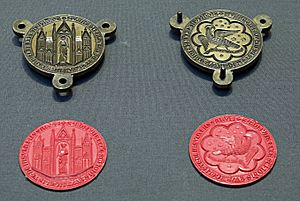Seal (emblem) facts for kids
A seal is a special tool used to make a unique mark, like an impression, on soft materials such as wax, clay, or even paper. The mark itself is also called a seal. Long ago, people used seals to prove that a document was real or to make sure a package hadn't been opened. Think of it like a very old-fashioned lock!
The tool that makes the seal is called a seal matrix or die. The mark it leaves behind is called a seal impression. If the mark is just a raised design on paper, it's called a dry seal. Sometimes, ink or another colored liquid is used to make the impression stand out.
Most seals have a design carved into them that is "intaglio," meaning it's cut below the surface. This makes the impression appear in "relief," or raised above the surface. The design on the impression will be a mirror image of the tool. This is super important if there's writing on the seal!
In medieval Europe, some important groups like towns or kings used two-sided seals. These made impressions that dangled from documents, often attached by a ribbon or a strip of parchment. These "pendent" seals hung below the papers they proved were real.
Today, some places consider a rubber stamp or words like "seal" or "L.S." (which means "place of the seal" in Latin) to be just as good as a traditional seal. In the United States, you might see the design of a seal, like the Great Seal of the United States, on things like flags or money. But in Europe, seals are mostly used for their original purpose: making impressions on important documents.
The study of seals is called sigillography.
Contents
Ancient Seals
Seals have been used since the very first civilizations. They are very important for archaeologists and art historians.
Stamp Seals
The stamp seal was a common type of seal. It was often carved from stone. People have found stamp seals from as far back as 6000 BC! The oldest ones were shaped like buttons with simple designs carved into them.
Cylinder Seals
In ancient Mesopotamia, people used carved cylinder seals. These were made of stone or other materials. You could roll them across wet clay to create a repeating pattern. They were used to label goods for trade or for other purposes. Many cylinder seals have detailed pictures, and some also have writing. People probably wore them around their necks on a string.
Ancient Egypt also had seals, often in the form of Signet rings. Some of these rings even had the names of kings written in hieroglyphics.
Seals in East Asia
In places like China, Korea, and Japan, seals have been used for identification since the Qin dynasty (221 BC). They are known as yinzhang in China. Early seals were pressed into soft clay. But from the Tang dynasty onwards, a red ink made from cinnabar was usually used.
Even today, these seals (sometimes called "chops") are commonly used instead of handwritten signatures. They help to prove that official documents or money transactions are real. Both individuals and organizations have official seals. These seals often have the names of the people or groups they represent. They can also have poems or personal sayings.
East Asian seals are carved from hard materials like wood, soapstone, or jade. They are used with a red, oil-based paste. Carving seals is considered a form of calligraphy in East Asia. There are many different carving styles. Some seals are so artistic that it's hard for people who aren't trained to read the characters. Seal carvers are seen as artists. Some seals made by famous carvers, or owned by famous people, are now valuable works of art.
Every seal is unique because they are made for individuals by artists. The materials and carving styles often match the owner's personality. Sometimes, seals are carved with the owner's zodiac animal on top. They can also have images or calligraphy on their sides.
You might see East Asian seals on traditional paintings from China, Japan, and Korea. These paintings are usually watercolors on silk or paper. They often have several seals, including one or two from the artist and seals from the painting's owners.
Western Seals
The seals used in the ancient world led directly to the seals used in medieval and modern Europe. These seals were most often pressed into sealing wax. In the Middle Ages, sealing wax was mostly beeswax mixed with resin. Later, more resin was used. In the early Middle Ages, lead seals, called "bullae," were also common. Byzantine Emperors sometimes used gold seals called Golden Bulls.
Wax seals became common in royal offices in Western Europe by the late 10th century. In England, very few wax seals from before the Norman Conquest have survived. The practice of using wax seals slowly spread down through society. By the 13th century, ordinary free people were using them. Many groups like churches, towns, and monasteries also used seals to approve their actions.
Today, traditional wax seals are still used on very important documents for ceremonies. But in the 20th century, they were mostly replaced by inked or dry embossed seals and rubber stamps.
In many Western countries, private citizens don't usually use seals anymore. However, in Central and Eastern Europe, like in East Asia, a signature alone isn't enough to prove a business document is real. Many managers and employees have personal seals, usually just with their name and job title. They use these on letters, invoices, and other documents. Today, these are often plastic self-inking stamps.
Notaries (people who can legally witness signatures) still use seals every day. In Britain, each notary has their own personal seal registered with the government. It includes their name and often a picture of an animal.
How Seals Were Used
Seals are mainly used to prove that documents are real, especially legal ones. There are two main ways a seal can be attached to a document:
- Applied seal: This is when the seal is pressed directly onto the paper or parchment.
- Pendent seal: This is when the seal hangs loose from the document. It might be attached with cords, ribbons, or strips of parchment threaded through holes in the document.
The goal was always to make sure the document and seal stayed together and to prevent the seal from being reused. If someone tried to remove an applied seal, it would usually break. A pendent seal could be cut off, but it would be very hard to attach it to another document without breaking it.
In the Middle Ages, most seals were pendent. They were attached to legal papers and "letters patent" (open letters that gave rights or privileges). For important agreements, all people involved, plus witnesses, might attach their seals. Many governments still use pendent seals for important official letters.
Applied seals were originally used to seal a document closed. The paper would be folded, and the seal would be pressed onto the fold. This way, you couldn't open the document without breaking the seal. This was used for "letters close" (letters meant only for the person receiving them) and packages. It showed if the item had been opened or tampered with. It also proved the item was from the sender. Later, people used applied seals for private letters.
Seal Designs
Historically, most seals were round. But you can also find oval, triangle, or shield shapes. The design usually had a picture or symbol, sometimes with heraldry (family symbols), surrounded by words. These words, called the legend, often said "The seal of [owner's name]" in Latin or the local language. Sometimes, the legend was a motto.
In the Middle Ages, seals for women and church leaders were often shaped like a pointed oval, called a vesica. The main picture was often a standing figure of the owner or a saint. Medieval townspeople used many different symbols. Some had seals with images related to their jobs.
Sealing wax was naturally yellowish or brownish. But it could also be colored red or green. In some medieval royal offices, different wax colors were used for different purposes or departments.
Some pendent seals had a smaller counter-seal used to make a small mark on the back of the impression. Sometimes, the seal and counter-seal were kept by two different people. This added an extra check to make sure the document was real. Other pendent seals were double-sided, with detailed designs on both sides.
When a person who owned a seal died, their son or heir might order a new seal with the same symbols. This practice might have helped create the idea of heraldry in Europe in the 12th century.
Seals for Professionals
Seals are also used on documents for buildings, engineering projects, or land surveys. They show that a licensed professional supervised the work. Depending on the rules, these seals might be embossed, stamped, or even a digital image with a special digital certificate. The names on these professional seals show who is legally responsible for any mistakes.
In some places, like Canada, it's a legal rule for professional engineers to seal documents. This seal shows that the work was done by, or supervised by, a licensed professional engineer. It assures people that the work meets high standards.
Destroying Seals
Because seals were so important for proving things were real, old seals had to be destroyed when authority changed hands. A new seal would then be made. For example, when a Pope dies, the first job of the Cardinal Camerlengo is to get the Ring of the Fisherman (the Pope's special signet ring) and make sure it is broken. This shows that the old authority has ended.
This practice also happened in the Middle Ages. When a bishop or abbot died, their seal would be publicly broken. This showed that their power had passed on.
When King James II of England lost his throne in 1688, he supposedly threw the Great Seal of the Realm into the River Thames. He wanted to stop the government from working. The seal was found later, and his successors used it, slightly changed, to show that the government continued.
Signet Rings
A signet ring is a ring with a flat top that works like a seal. It usually has a design, often a family crest, carved into it. This carving is "intaglio," meaning it's cut inwards. So, when the ring is pressed into liquid sealing wax, it leaves a raised (relief) impression of the design. The design is often made from stones like agate or carnelian, which don't stick to wax. Many small ancient engraved gems were probably worn as signet rings or as seals on necklaces.
People have worn signet rings since ancient Egypt. The Bible even mentions a pharaoh giving his signet ring to Joseph. Because it shows the authority of the person wearing it, the ring has also become a symbol of power for kings and queens.
Signet rings are also used as souvenirs or to show membership, like class rings that have a school's crest. People might also have their initials engraved on them.
Signet rings became less popular for a while in the 17th century but became popular again in the 18th and 19th centuries. Since the 16th century, some rings have been made where the engraving isn't reversed. This means the impression won't read correctly.
Rings have also been used in spying. During World War II, some US Air Force members bought signet rings with hidden compartments for small compasses or secret messages.
Modern Tamper-Proofing
Today, seals are used to prevent tampering. For example, gas and electricity meters might have lead or plastic seals with government marks. These seals are attached with a wire that goes through part of the meter. The meter can't be opened without cutting the wire or damaging the seal. This prevents people from changing the readings.
There are also special tamper-evident labels. These labels are destroyed if the container or equipment they protect is opened. They work like a modern wax seal. They are used to protect things like medicines or equipment where opening it would cancel a warranty.
Figurative Uses
The phrase "seal of approval" means a formal OK or permission from an important person or group. It doesn't always involve an actual seal.
It's also part of the name for some quality marks, like:
- Good Housekeeping Seal of Approval
- Good Netkeeping Seal of Approval
See also
 In Spanish: Sello (cuño) para niños
In Spanish: Sello (cuño) para niños
- Company seal
- Keeper of the seal
- Great seal
- King of Na gold seal, a famous seal from Japan
- Knights Templar Seal
- Manu propria
- Privy seal
- Signet ring cell




















